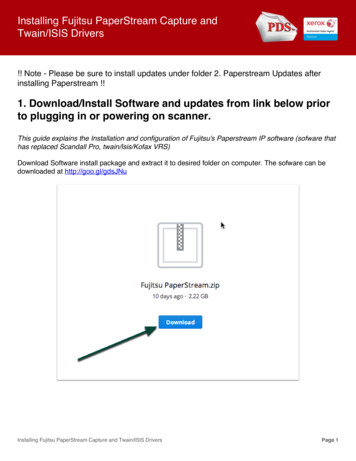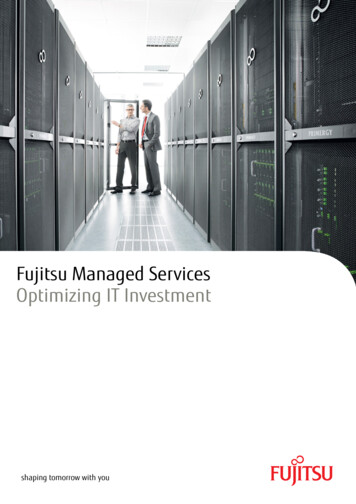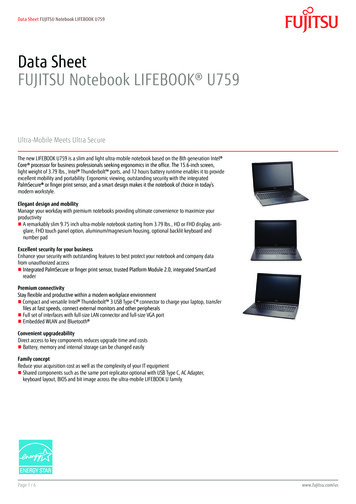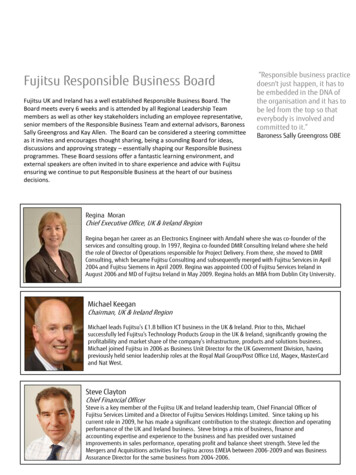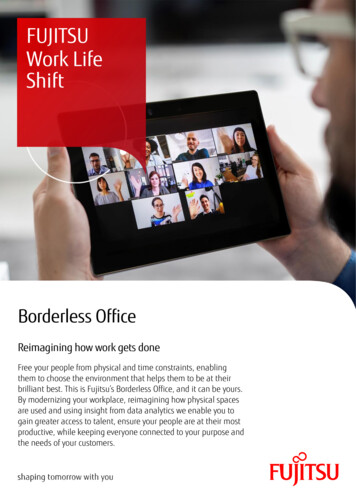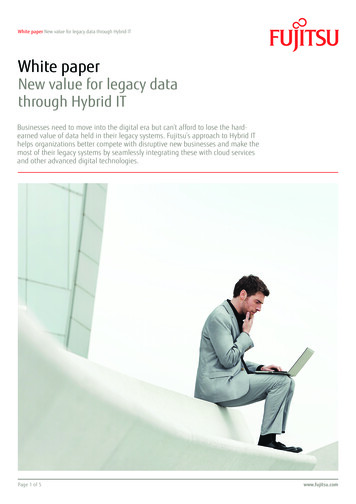
Transcription
White paper New value for legacy data through Hybrid ITWhite paperNew value for legacy datathrough Hybrid ITBusinesses need to move into the digital era but can’t afford to lose the hardearned value of data held in their legacy systems. Fujitsu’s approach to Hybrid IThelps organizations better compete with disruptive new businesses and make themost of their legacy systems by seamlessly integrating these with cloud servicesand other advanced digital technologies.Page 1 of 5www.fujitsu.com
White paper New value for legacy data through Hybrid ITIntroductionCompanies have all kinds of data, some of it decades old, stored ontheir systems. There’s data about products, finance, research anddevelopment, personnel, customers – the list is endless. Much of it isheld in legacy systems, often multiple systems that don’t connect to orcommunicate with one another. But imagine being able to access allof this data through digital technologies like cloud services and viadevices such as tablets and smartphones. Imagine being able to applyanalytics to better understand how your product portfolio hasdeveloped over the years, how your customers have responded to it,how your user base has grown and shifted, how customer segmentsand requirements have changed over time.Using advanced technologies like the cloud, Big Data analytics,machine learning and more could free your legacy data and bring itinto the digital age. By doing so, you can generate new value from olddata systems and improve your ability to compete in today’sdisruptive, ever-changing business environment. That’s moreimportant than ever with the rise of new digital-first, billion-dollartrailblazers like Uber.Hybrid approachThere are many reasons for a company to move applications awayfrom legacy systems and into the cloud: greater flexibility, fastersupport for innovation and improved adaptability to changing securityand regulatory demands, not to mention the potential for reducedoperational expenses. However, making the business case fortransformation isn’t necessarily simple or straightforward.Moving to the cloud, for example, does not immediately eliminate allof a company’s legacy IT demands or expenses. Nor is software-as-aservice always less expensive than in-house systems. For manycompanies, a hybrid approach combining some elements of legacyand some elements of public and private cloud can be the mostefficient – and cost-effective – solution. Achieving the right balance oftechnologies, though, requires careful planning and smart strategies.Taking such steps is vital for legacy companies that hope to competewith disruptive businesses built from the ground up on digitaltechnologies. These businesses – which today operate in everycategory from dining and delivery to events, transportation andpersonal services – are succeeding because they have found breakoutopportunities in new digital models.Traditional and digital business modelsEven the most traditional companies today have an online presence ofsome kind. However, for many that presence is just an extension ofthe traditional business model, rather than a true digital businessmodel.Becoming truly digital requires much more than a website or anonline store. Companies that make the transformation can, forexample, use analytics to optimize services and channels and totarget customer groups. This lets them focus on up-selling and crossselling and helps them learn more about their target customers’shopping habits. Armed with such insights, they have a clearcompetitive advantage over companies still stuck in traditionalbusiness models. Businesses today that haven’t pursued digitaltransformation are at risk of becoming irrelevant in the marketplaceand of disappearing.Page 2 of 5New digital business models pose a threat to legacy firms. While Uberlike personal services and products differ in form and execution, theirvalue propositions are more tuned in to modern consumers’ highexpectations. They are chasing traditional companies’ customers,market share and profits. And they’re doing this across every sector,reconfiguring how benefits will be profitably delivered to consumers.Many companies still depend on legacyDespite the drive toward digital, many companies still depend on dataheld in legacy IT systems. Maybe they do this because they’redependent on a long-time supplier or because they fear change.Through digital transformation, businesses can turn end-of-life systemsinto valuable assets, rich with historical data. However, the challenge isunlocking that data in a non-disruptive way.If replacing a legacy system is out of the question, it’s possible toenhance one with new functionality by building interfaces to otherapplications. Middleware, for example, offers a proven technology toadd web-based interfaces to old mainframe applications. This createsthe illusion of a ‘new’ system, keeping all existing functionality withlittle need to train end-users. The downside is it creates an extra layerbetween the business and the supporting functions, resulting in longerresponse times.Another solution is to build completely new systems that connect tolegacy IT, turning old records into valuable databases. This approachcan add new functionality for digital business. However, future changesand upgrades will be costly and time-consuming, as the legacy systemstill needs to be maintained.Finally, there’s the option of migrating the legacy environment to thecloud. The challenge here is finding a future-proof platform that cansupport different types of cloud and can also integrate with the legacyenvironment. The hybrid approach enables gradual migration from oldsystems (according to business function, legacy module, database, etc)in a way that addresses business concerns about continuity, risk,change and transformation management.Whatever transformation strategy traditional companies pursue, theycan turn the undervalued historical data in their legacy systems into abig advantage. By placing this information in the context of decades ofmarket, customer and product development, they can reap enormousmarket potential. But this works only when they are supported by theright IT infrastructure that allows them to ‘Uber-ize’ their currentbusiness models.Starting with value creation and commercializationTo succeed in the digital age, businesses need to understand theircustomers better than ever. This means analyzing customer needs,interests and concerns, financial and otherwise. By doing this,companies gain insights into value drivers so they can better alignservices to customer demands. They can identify new opportunities forsales and services and find new ways to differentiate their services fromthe competition’s. They can also find new ways to quantify andcommunicate value to customers.www.fujitsu.com
White paper New value for legacy data through Hybrid ITService developmentWhatever services they offer, businesses need to structure these sothey are easy to apply, scalable, repeatable and efficient. Doing thisrequires them to create rules and guidelines for developing services,for instance, via DevOps.Consider how digital disruptors like Uber develop and deliver services.These cutting-edge companies transform their personal services into asynonym for products, creating a valuable and attractive alternative inconsumers’ minds. It all boils down to conversion: If a brand is not aservice today, its value needs to be tied to a service. This, in turn,should convert a low-value asset into a more valuable service. WithUber, for example, idle car and driver assets are converted from nonuse to use.In the same way, traditional companies must embed their productsand goods into services or find services to embed them. The value ofproducts then becomes more than the product itself.To succeed in service industrialization, companies must take twocritical steps. First, they need to ensure that service development isoutside-in, creating value for customers, rather than just an inside-outapproach based on technology or products. Second, they need to builda service structure that enables efficient, flexible creation of customerspecific services from standardized components. This structure andthese components should be also digitalized to ensure standardizationand repeatability.Service development versus product developmentTo develop services that create value for themselves and theircustomers requires businesses to take both an inside-out and anoutside-in approach. They also need to understand their market andtheir competition.Companies can develop personalized, customer-specific services bychoosing a modular, standardized structure that makes it easy to tailorofferings on a case-by-case basis. A clearly defined service structurecan also enhance sales teams’ understanding of available services andthus improves their ability to respond to customer needs. In short, awell-defined service structure promotes cross-selling and boosts salesgrowth.Another key to modern competitive services is ensuring they can bedelivered on demand. Such services are available anytime, anywhere.Mobile apps play a crucial role in delivery, but it is really aboutfulfilment in whichever way is fastest. In short, this is about movingfrom a ‘go-to’ marketplace to a ‘come-to’ marketplace, where benefitsor services come directly and immediately to consumers. This digital‘Uber-type’ business model is also based on pay-as-you-go. Brands sellonly what a consumer needs in that moment, no more.Transforming legacy into a Hybrid IT modelMany companies are looking to rapidly transform their customerfacing services. But they also face the challenge of providing a stableplatform for ongoing operations such as processing orders, bookingsales, setting schedules and ensuring regulatory compliance. If any ofthese back-office processes, which often reside on legacy platforms,fail or go down, the results for a business can be disastrous.Page 3 of 5There are also risk and time challenges. Accelerated transformationcan lead to data that does not integrate and systems that go down.The IT department can also find itself overwhelmed by trying to makeeverything happen at once.So how can the need for agility in the market be balanced with theneed for stable back-end systems? The alternative to an all-or-nothingapproach is Hybrid IT. This dual-speed strategy lets digital and legacysystems coexist, giving businesses the time and resources they needto manage disruptive change.Digital transformation: customer-facing systemsHigh on the list of priorities for digital transformation are applicationsfocused on customer experience. These help companies providecompelling and personalized user experiences that are effective viaany device or channel. Such systems draw data from multiple parts ofthe organization, bringing everything together for customers in oneseamless transaction.Consequently, the first proposition for deploying Hybrid IT is to fasttrack customer-facing functions such as ecommerce, CRM and socialmedia. This approach will quickly raise digital standards to wherecustomers need them most.Hybrid IT supports coexistence between newemerging digital and legacy systems managingthe dilemma of disruptive changeBack-office transformation: internal-facing systemsWith the initial focus on customer-facing systems, the IT team cantake a less rushed, more risk-managed approach toward internalfacing applications. These systems are often tightly integrated into theback-office operations of the company. For example, an orderfulfilment system will pass through sales, finance, inventory, logisticsand customer management.These systems do not need to be upgraded as frequently as otherdigital applications that must keep up with competitors and consumerdemand. Refresh cycles can be scheduled as dictated by internalneeds or supplier maintenance schedules.Many of these internal systems are built on legacy technologies orproprietary (or even bespoke) systems, which do not support rapidtransformation.For example, monolithic ERP systems are good candidates for a HybridIT approach. The traditional concept of end-to-end systems like ERPreduces agility and the ability to compete. The challenge now is tobreak up the company’s legacy systems and not to replace the entireERP environment. The hybrid approach helps modernize specificportions of these systems through cloud-based software-as-a-service.Legacy systems can be connected to new digital infrastructures withminimal disruption through the use of APIs (application programminginterfaces).www.fujitsu.com
White paper New value for legacy data through Hybrid ITIn other words, these systems do not remain static. The back-officetrack allows for a sequence of mini transformations (perhaps financefirst, then supply chain, then distribution) in order of impact and easeof implementation. This means the IT department can pace itself andnot become overwhelmed by an over-accelerated transformation.Be disruptive from day one and take the necessary time to transformHybrid IT is not a permanent state of coexistence between twoseparate systems.At the current pace of change, even the most cutting-edge digitalsystems become legacy technology in a matter of months. Over time,companies that adopt Hybrid IT will find legacy systems becoming anincreasing burden on organizational agility and innovation. Thesesystems are also costly to maintain. Hybrid IT simply allows order,planning and time to prepare for a still needed, inevitable migrationpath.Eventually, many companies will want to move their IT architectures toa unified, highly agile digital platform. Hybrid IT is not a substitute forthis digital end game. It is just a measured, risk-managed andpractical route to getting there, enabling legacy businesses to bettercompete with their digital-native competitors.Business value from transformed and disruptive legacyHistorically, legacy systems are large and complex, supportingthousands of daily users accessing many hundreds of databases andservers. In addition to being expensive to maintain, these systems arealso difficult to scale to meet evolving business needs. This is due totheir silo-based, vertical nature, which makes for a complexinfrastructure with many dependencies. This makes it difficult tochange business processes, extract and correlate data and developnew capabilities.Slow to adapt to new technologiesIn most cases, legacy systems lack the agility to adapt to newtechnologies and business trends such as: Increasing demand for better and more rapid business intelligencecapabilities Shifting application development environments toward open-sourcearchitecture, providing reusable system components Evolving channels like netbooks, tablets and smartphonesbecoming common productivity tools in the company and channelsto end usersThe ‘how’ - legacy transformation processTransforming a company’s legacy environment and business processeshelps to create a more agile, more cost-efficient environment thatsupports high-velocity, disruptive business models. This can includerationalization to reusable service components that can be used indifferent ways across multiple business functions.Open sourceOpen source can be a key to transforming from a monolithic legacyenvironment to a more distributed environment. It can help developcommon pieces of business logic into service components that can beused by several different business processes. Open source promotesbusiness velocity and maximizes business value through reuse.One key benefit of open source is cost containment. Throughout thecompany, self-contained, isolated repositories of redundantapplication functionality and data can be consolidated. Consolidationreduces software lifecycle costs and the number of software licensesand servers required. Open source also increases IT agility, improvestime-to-market, results in better IT utilization and return oninvestment (ROI) and simplifies the enterprise architecture.Results of legacy transformationThe transformation of legacy systems greatly reduces systemcomplexity. It increases business value through increased agility andvelocity, improved reliability and support, provides a better userexperience and enhances cost efficiency.A new hybrid environment works by implementing horizontal andreusable components, minimizing customizations and transformingbusiness processes. Over time, it also makes it possible to graduallytransform the remaining legacy functions to the cloud.Improved velocityTransformation and Hybrid IT will support rapid growth and change inbusiness needs, processes and the enterprise applicationsenvironment. Patches from suppliers can be implemented in a matterof weeks with minimum resources. The hybrid, open-sourceenvironment also allows for DevOps approaches in all cloud types andeven in the legacy environment itself.Enhanced agilityBy transforming legacy systems, companies can identify and focus onhigh-value, differentiated business processes and rapidly deploysupporting capabilities. It is easy to plug new business intelligenceapplications into the hybrid environment. By identifying andstandardizing highly shared, integrated data within the cloud, thesebusiness intelligence applications can lead to actionable analytics thatsupport better decision making.The hybrid environment also makes it possible to offer supportfunctionality to other channels like tablets and smartphones.TransformationA transformation from a legacy environment to an open-source cloudinfrastructure may take several years to complete. Initially, the focuswill be mainly on technology and transferring suitable existingdatabases and applications to the cloud. After this, the focus can shiftto supporting business processes and transforming those applicationsfor cloud-native capabilities. DevOps can contribute to this process byquickly supporting new customer demands on top of the transferredsystems.Page 4 of 5www.fujitsu.com
White paper New value for legacy data through Hybrid ITHow Fujitsu helps to make this happeningWhen you add cloud-based IT to your existing in-house infrastructure,it’s important to remember that you are buying into a journey ratherthan a one-off change. The challenges in navigating that journeysuccessfully go beyond technology and money, with ramifications foralmost every aspect of your business.However, if you manage that path properly your business can reapnumerous benefits both now and into the future. Yes, the cloud offersflexibility and adaptability that no self-managed data center can. Butthe gains go far beyond that.ConclusionBuilding a proper business case for the move to Hybrid IT takes timeand effort. But make no mistake, it’s essential. To ensure your journeyproceeds as smoothly as possible, ask tough questions about whatyou hope to achieve. And look for answers that address concerns foreveryone involved from employees and department heads to ITmanagers and executives in the C-suite.With a well-informed and focused approach to Hybrid IT, yourorganization can reap such benefits as greater flexibility, faster time tomarket, enhanced competitiveness and ‘quick-to-succeed, cheap-tofail’ innovation.Next stepsHybrid IT can help organizations build a flexible, future-proofinfrastructure while preserving time-tested and business-criticalelements of legacy IT. Fujitsu understands the challenges of suchtransformations first hand and can help customers successfullynavigate the journey to achieve the perfect balance of legacy andcloud.ContactASK FUJITSUTel: 44 (0) 1235 79 7711E-mail: e 5 of 5 2016 Fujitsu, the Fujitsu logo, [other Fujitsu trademarks /registered trademarks]are trademarks or registered trademarks of Fujitsu Limited in Japan and othercountries. Other company, product and service names may be trademarks orregistered trademarks of their respective owners. Technical data subject tomodification and delivery subject to availability. Any liability that the data andillustrations are complete, actual or correct is excluded. Designations may betrademarks and/or copyrights of the respective manufacturer, the use of which bythird parties for their own purposes may infringe the rights of such owner.www.fujitsu.com
track customer-facing functions such as ecommerce, CRM and social media. This approach will quickly raise digital standards to where customers need them most. Back-office transformation: internal-facing systems With the initial focus on customer-facing systems, the IT team can take a less rushed, more risk-managed approach toward internal-



